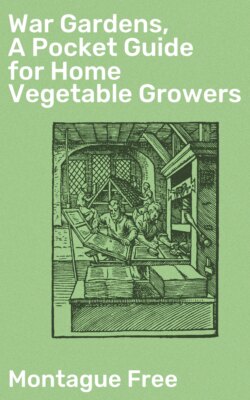Читать книгу War Gardens, A Pocket Guide for Home Vegetable Growers - Montague Free - Страница 6
III
TOOLS
ОглавлениеIt is unnecessary to spend much money on tools for use in a small garden. The writer did very well in his home garden with nothing but an ordinary round-pointed shovel for digging purposes, a rake to pulverize the soil and make drills for seed-sowing, a scuffle-hoe for cultivating, and a garden line made from two sticks and a piece of twine. Of course there are many tools on the market that greatly facilitate cultivation and make gardening work easier, but their purchase is inadvisable unless the size of the garden and the permanency of its cultivation warrant it.
Nothing will be said as to the various types of horse-drawn or motor-driven implements. This book is written for those who have to do their gardening with hand tools or those who are limited to the hiring of just what horse-drawn tools happen to be available.
For the preparation of the soil, probably the best implement is the spading-fork. It is easier to work with than a spade and in most cases is equally efficient. The spading-fork can be used for digging and, at a pinch, can be made to serve the purpose of fining the surface soil for seed-sowing. A spade is a handy tool to have, however, especially when any work is to be done in the way of making beds or forming walks.
For seed-sowing the absolute essentials are very few. A yard-stick or foot-rule for measuring the distance between the rows is useful. An even better way of accomplishing this is to divide a hoe or rake handle, whichever is used in seed-sowing, into feet and quarter-feet, preferably cutting in the marks with a knife. If one is limited to buying just one tool for making the drills the rake should be chosen, as it can also be used for fining the soil and for cultivating between the rows. A garden line can easily be improvised from two sticks, sharpened at one end, and a suitable length of strong twine.
When the soil is fairly loose and easily worked, a scuffle-hoe is a very satisfactory tool for cultivating the surface. On the other hand, if the ground is hard and stony the ordinary draw-hoe should be chosen. A small hand weeder, which can be obtained at a cost of from ten to fifty cents, is very useful for loosening the surface of the ground close to the rows of young seedlings. Look over the illustrations of these tools in a seedsman’s catalogue and pick out the one most suited to your needs. With a little ingenuity, tools suitable for stirring up the surface soil can be fashioned at home from old hoop iron or stout wire fastened on wooden handles. After a season’s work in the garden you will discover just what you need in this line, and will probably be able to make a tool that will give far greater satisfaction than anything you might buy.
A garden hose of sufficient length so that water can be applied all over the garden is an advantage, but not absolutely necessary. A good rubber hose costs, nowadays, about ten dollars for a length of fifty feet, and a few expenditures of this nature sadly eat into the profits of the garden. As an accessory to the hose a sprinkler throwing a fine spray, that can be left running for several hours, is very useful and desirable, especially if there is no meter attached to your water supply!
When combating insects and diseases in a small garden, a sprayer of the atomizer type holding about a quart of insecticide and costing between one and two dollars is very valuable. In a garden of considerable extent, or in a community garden, insecticides and fungicides can be economically and efficiently applied by means of a compressed-air spray-pump holding three or four gallons and costing between six and eight dollars. If a large potato-patch is cultivated, a powder-distributing bellows, costing about one dollar, is useful for distributing Paris green in powder form. A powder-distributer for use in a small garden can be improvised by making a small cheese-cloth bag in which the powder is placed and distributed by shaking the bag over the plants.
Wheel-hoes varying in price from five to fifteen dollars—the price depending on the size and number of attachments—are available for expediting the work in large gardens. Some of these implements have attachments so that they may be used for marking the rows, sowing seeds in drills or hills, for raking, cultivating, and shallow plowing. These, however, are for use on large areas by professional gardeners, or to delight the connoisseur of tools.
To sum up—the tools that it is advisable for a beginner, with a garden of moderate size, to buy are: a spading-fork, an iron rake, a six-inch hoe (of either the scuffle or the ordinary variety), a one-quart atomizer for applying spray fluids, and a watering-can. The cost of these should not exceed three or four dollars.
Start out with a few essential tools and add others if you find that you absolutely need them.
